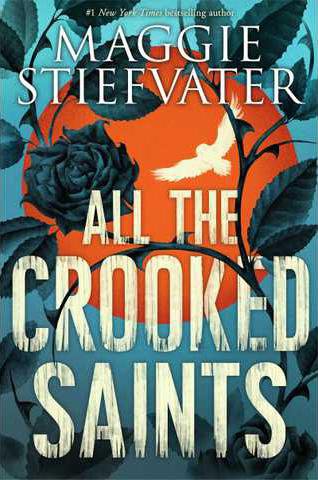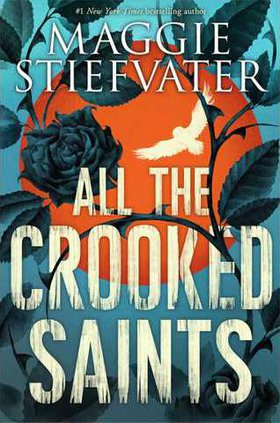Any reader familiar with author Maggie Stiefvaters work knows her worlds are full of darkness, magic and the ties that bind all humans together. In her latest novel, All the Crooked Saints, Stiefvater returned to these concepts but instead of magic explored the idea of miracles.
The switch to miracles from magic was a simple one for Stiefvater.
I felt like the real world needed some improvement (I still do), and miracles felt more plausible than magic, Stiefvater wrote in an email interview.
Miracles are more than plausible for the small, fictional town of Bicho Raro, Colorado they are part of the family tradition. "All the Crooked Saints" follows the idiosyncratic Soria family as they perform miracles for the pilgrims who come to Bicho Raro in search of solutions to their problems.
The idea for All the Crooked Saints started in a desert town when Stiefvater had a problem that needed solving.
My car broke down in the San Luis Valley a few years ago, and as I stood there surrounded by that brittle desert and those sharp-edged mountains (not too different from Utah, really), I thought: this is where my next novel should take place, Stiefvater shared.
After she had her setting, a lot of factors went into fleshing out that initial idea.
Every book is a mish-mash of inspiration a ravens collected miscellany of life experience, news stories, interesting art and inspiring music. The folklore and history of the desert really shaped the novel from that point on. Once I made the decision to set it in 1962, the setting informed the book even more. That corner of the world was a very lonely place back then, wrote Stiefvater.
Stiefvaters characters are imbued with this loneliness, particularly the Soria family who have their own needs for miracles, but are unable to perform them for themselves.
This blending of realism and the unbelievable is how the story went from a broken down car epiphany to words on the page.
The entire tone of the book was shaped by one early paragraph, actually, Stiefvater wrote. Its a paragraph where Im minding my own business, describing owls in a very scientific and factual way, and then I wrote a line about how everyone knew owls were very attracted to miracles. As soon as I wrote that, I thought: this is what the rest of the book will look like. An absurd and tangled mix of science, magic, story and truth.
The science and truth part required a lot of research.
Research is a pleasurable labor for all of my novels. The exploration of the idea should be as satisfying as the execution, or whats the point? For "All the Crooked Saints," I dove into Colorados history; Mexican folktales; the intersection between how my childhood Catholicism and Mexican Catholicism looked at saints; Elvis; radio dishes; and cock-fighting.
Stiefvater also found inspiration in books and films, diving into well-known magical realism authors Isabel Allende, Grabriel Garca Mrquez, Erick Setiawan, Laura Esquivel and Joanne Harris and revisiting the films "Big Fish," "Amlie," and "Chocolat," hoping to capture their brand of magic for her book.
"All the Crooked Saints" has an omnipresent narrator, which lends to the story's magical ebb and flow. With all of these influences, character arcs and subplots, the story may seem hard to follow, let alone write, but Stiefvater found harmony in the complications.
For me, it felt like fewer character arcs because so many of them were inextricably tied together really the book is about unity, so the main character, one could argue, is really just the Soria family in its entirety, Stiefvater wrote.
Her characters take a physical pilgrimage in order to lead to a spiritual makeover, something Stiefvater finds important for anyone hoping to make a change in their life.
"I think its hard to change our insides when our outsides look the same, Steifvater shared. Often changing the internal mechanics of your life is slow, but an external change can act as a mission statement. A glorious first step. A concrete proof of your desire to change.
While for the characters in "All the Crooked Saints" this sometimes requires a miracle, Stiefvater has her own thoughts on miracles.
The hardest part of believing in miracles is realizing that sometimes, its up to you to be the miracle for someone else.
The switch to miracles from magic was a simple one for Stiefvater.
I felt like the real world needed some improvement (I still do), and miracles felt more plausible than magic, Stiefvater wrote in an email interview.
Miracles are more than plausible for the small, fictional town of Bicho Raro, Colorado they are part of the family tradition. "All the Crooked Saints" follows the idiosyncratic Soria family as they perform miracles for the pilgrims who come to Bicho Raro in search of solutions to their problems.
The idea for All the Crooked Saints started in a desert town when Stiefvater had a problem that needed solving.
My car broke down in the San Luis Valley a few years ago, and as I stood there surrounded by that brittle desert and those sharp-edged mountains (not too different from Utah, really), I thought: this is where my next novel should take place, Stiefvater shared.
After she had her setting, a lot of factors went into fleshing out that initial idea.
Every book is a mish-mash of inspiration a ravens collected miscellany of life experience, news stories, interesting art and inspiring music. The folklore and history of the desert really shaped the novel from that point on. Once I made the decision to set it in 1962, the setting informed the book even more. That corner of the world was a very lonely place back then, wrote Stiefvater.
Stiefvaters characters are imbued with this loneliness, particularly the Soria family who have their own needs for miracles, but are unable to perform them for themselves.
This blending of realism and the unbelievable is how the story went from a broken down car epiphany to words on the page.
The entire tone of the book was shaped by one early paragraph, actually, Stiefvater wrote. Its a paragraph where Im minding my own business, describing owls in a very scientific and factual way, and then I wrote a line about how everyone knew owls were very attracted to miracles. As soon as I wrote that, I thought: this is what the rest of the book will look like. An absurd and tangled mix of science, magic, story and truth.
The science and truth part required a lot of research.
Research is a pleasurable labor for all of my novels. The exploration of the idea should be as satisfying as the execution, or whats the point? For "All the Crooked Saints," I dove into Colorados history; Mexican folktales; the intersection between how my childhood Catholicism and Mexican Catholicism looked at saints; Elvis; radio dishes; and cock-fighting.
Stiefvater also found inspiration in books and films, diving into well-known magical realism authors Isabel Allende, Grabriel Garca Mrquez, Erick Setiawan, Laura Esquivel and Joanne Harris and revisiting the films "Big Fish," "Amlie," and "Chocolat," hoping to capture their brand of magic for her book.
"All the Crooked Saints" has an omnipresent narrator, which lends to the story's magical ebb and flow. With all of these influences, character arcs and subplots, the story may seem hard to follow, let alone write, but Stiefvater found harmony in the complications.
For me, it felt like fewer character arcs because so many of them were inextricably tied together really the book is about unity, so the main character, one could argue, is really just the Soria family in its entirety, Stiefvater wrote.
Her characters take a physical pilgrimage in order to lead to a spiritual makeover, something Stiefvater finds important for anyone hoping to make a change in their life.
"I think its hard to change our insides when our outsides look the same, Steifvater shared. Often changing the internal mechanics of your life is slow, but an external change can act as a mission statement. A glorious first step. A concrete proof of your desire to change.
While for the characters in "All the Crooked Saints" this sometimes requires a miracle, Stiefvater has her own thoughts on miracles.
The hardest part of believing in miracles is realizing that sometimes, its up to you to be the miracle for someone else.





